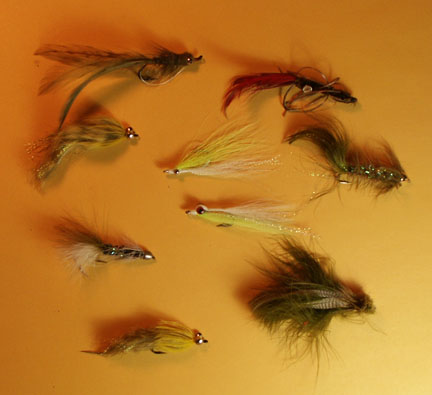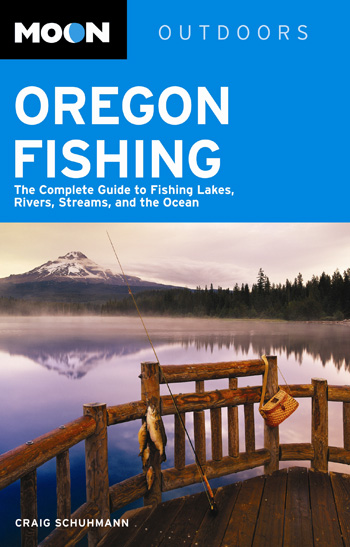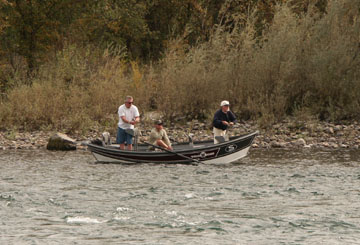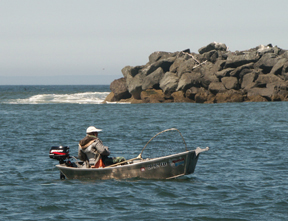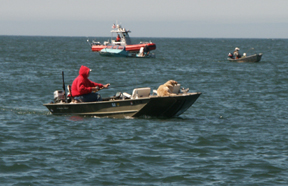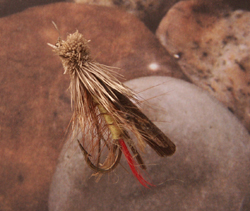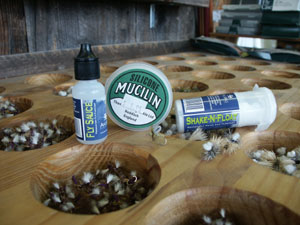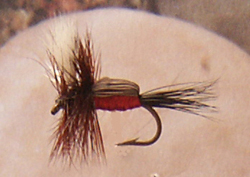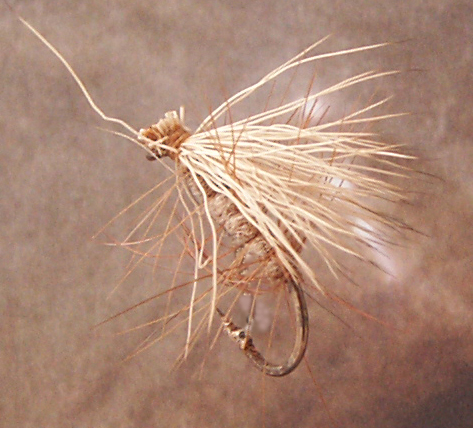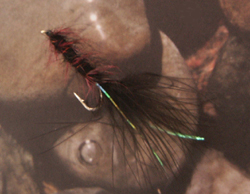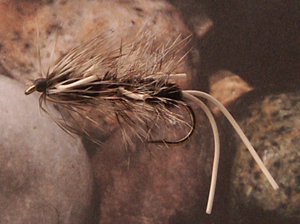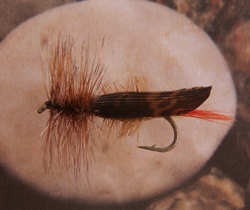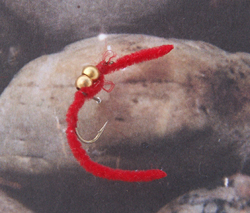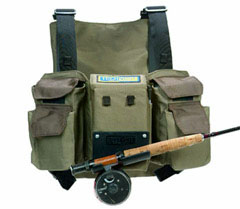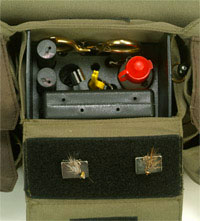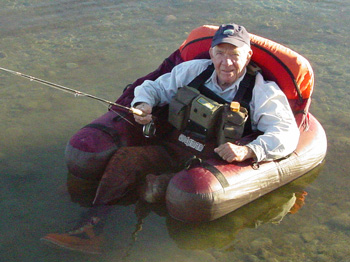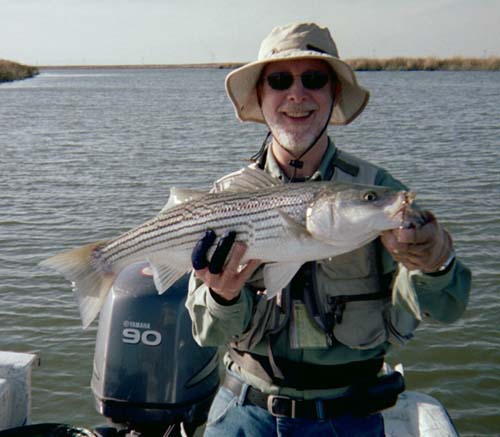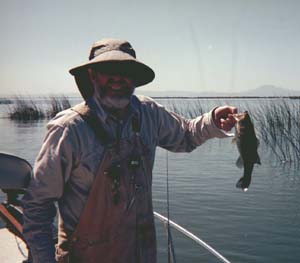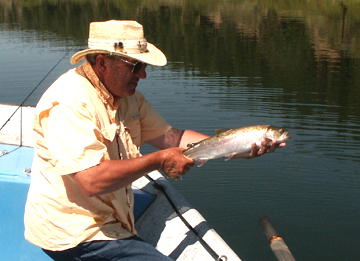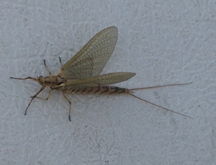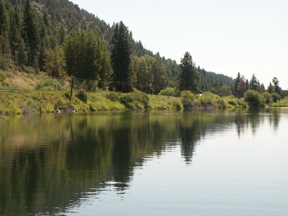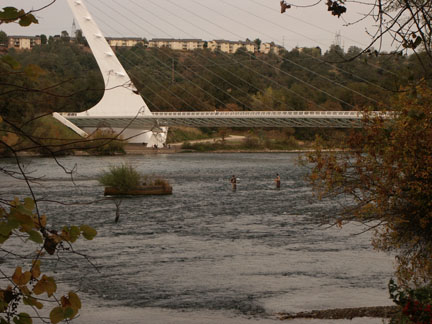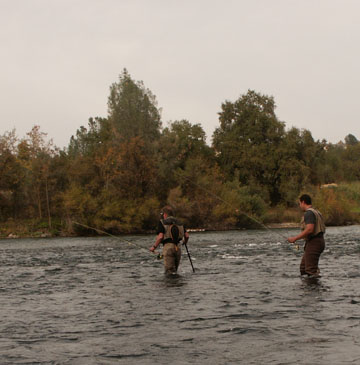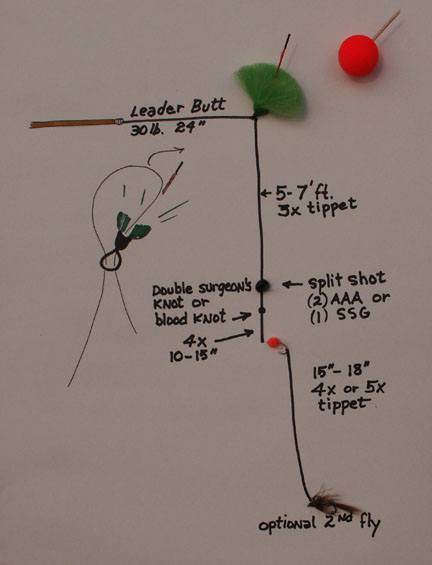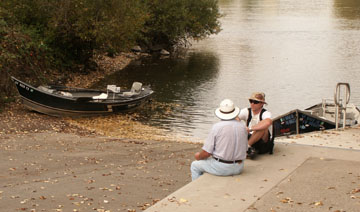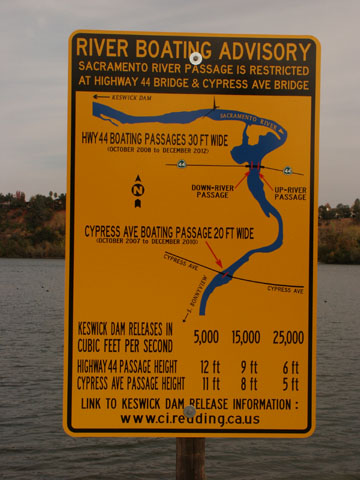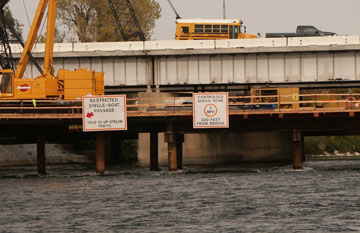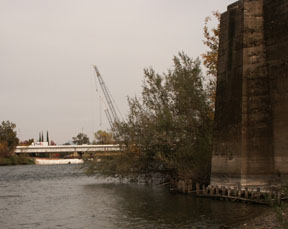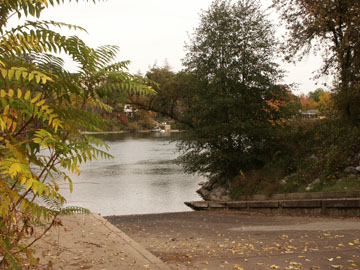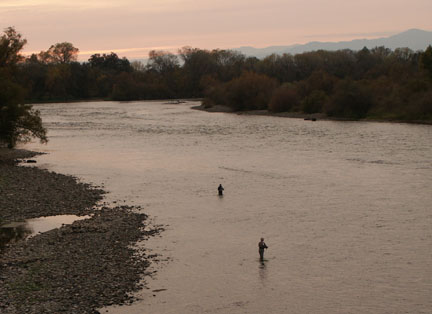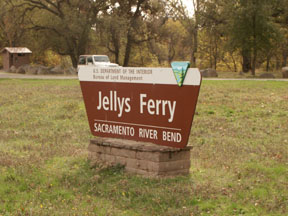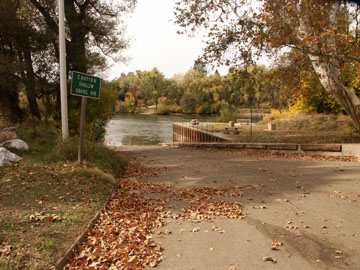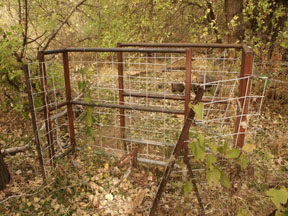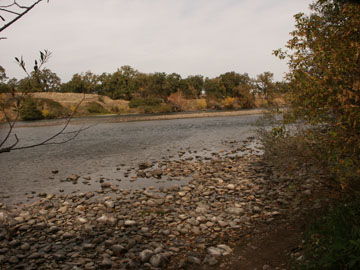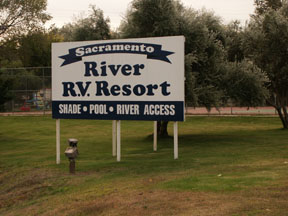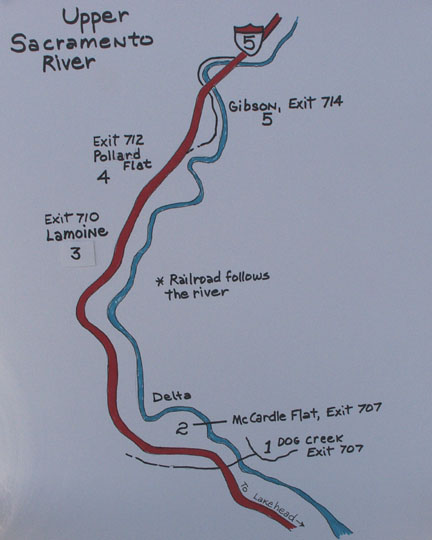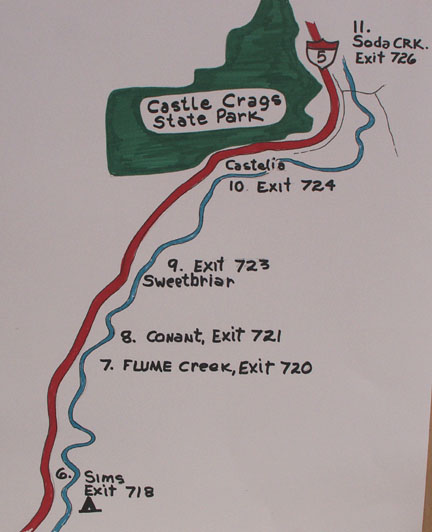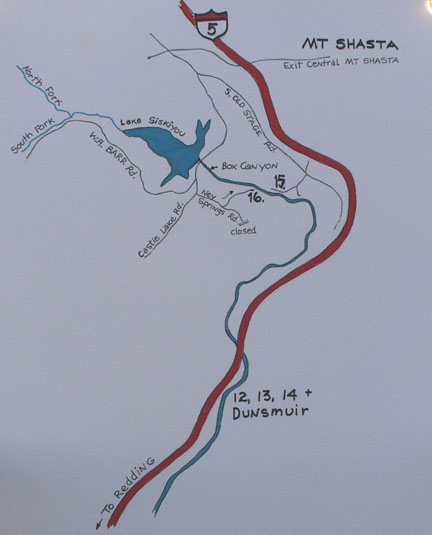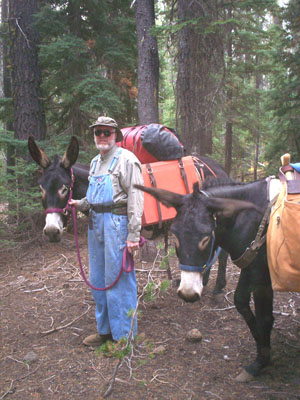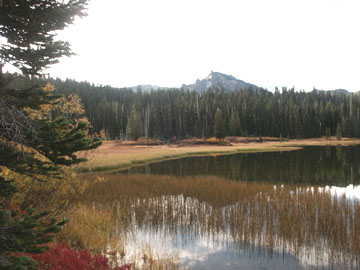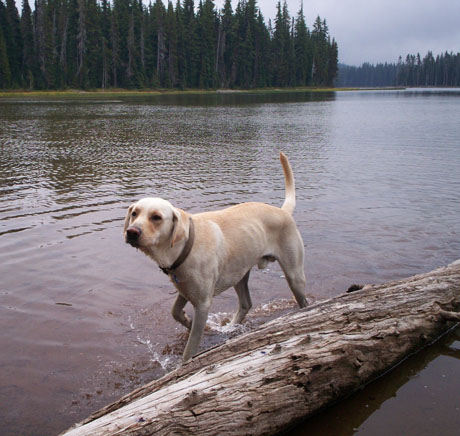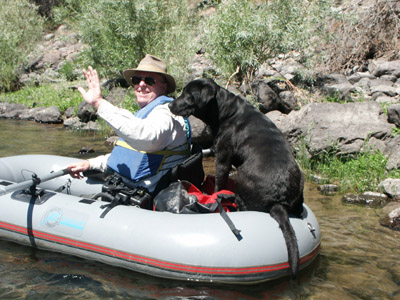
Part I: Safety, Preparation and Rowing Techniques
Part II: Advantages of Kick Boats and One-Man Rafts
Part III: Float Fishing Strategies
Note: The Waterstrider rafts depicted in this article are build by Dave Inks in Hamilton, Montana.
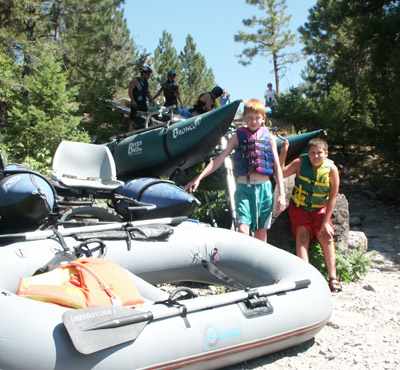
When I moved to Wyoming in my twenties, I signed up for a hunter's safety course. At least thirty people of all ages shuffled into the Game and Fish meeting room and took their seats on the folding chairs. People talked quietly, as if they were in a church. Presently a uniformed spokesman, after some preliminary discourse, asked a profoundly simple question. "How many of you attending this Hunter's Safety Class have experienced an accident or a near accident involving firearms?"
I was shocked with how quickly at least three-fourths of the attendees raised their hands. I was also struck with the honesty and quickness in raising their hands. My own hand had been slow to rise, in part from some deep seated shame of having pointed an "unloaded" gun at an adolescent friend with my finger on the trigger. Fortunately, a respected family member's instruction a year or two previous to this horrific moment came to the forefront of my senses, and I lowered the .22 rifle. I opened the chamber for my friend's inspection. When the .22 shell ejected, I apologized and made a hasty retreat to the bathroom where I quelled my nausea.
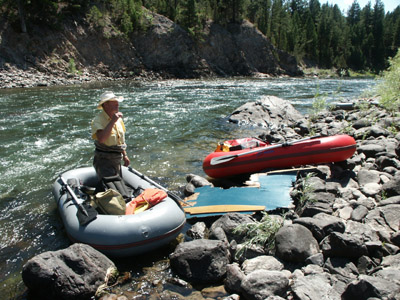
I would submit that any assemblage of river floaters, if asked to raise their hand owning up to a water accident or boating accident, would be slow to respond, not from a lack of honesty but out of sheer ignorance. Unlike firearm accidents, boating accidents do not have a smoking gun. They do not have a pulled trigger. What they do have is a perilous temptation with death or injury that is perpetrated out of ignorance or carelessness. Unlike the discharge of a firearm, with its instantaneous report of death or injury, potential river tragedies often go unnoticed. Float fishing from a personal water craft rewards anglers with increased fishing success and miles of scenic beauty; a successful outing, of course, requires safe preparation, good rowing skills, self-rescue knowledge, along with effective fishing techniques.
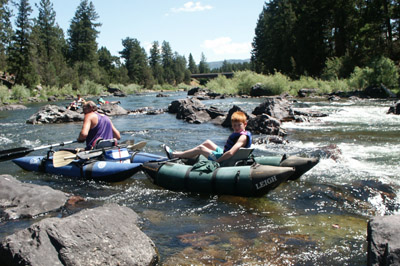
Safety
Anyone who has lost a loved one from a boating accident knows the importance of wearing an approved life jacket. I have always distained wearing a life vest, as they are hot and get in the way of my casting. After a near drowning accident at age 60, I wear a suspenders vest with an inflatable C02 pull-string. I don't even know that I have it on, and I do keep it on even in shallow, innocuous looking water. Keep a lifeline or throw rope handy, especially if you are floating with a group. Bring along plenty of rope and a first aid kit. A dry bag for extra clothes is essential. Keep this bag where it can be easily reached. Add to this bag the necessary provisions for starting a fire, and be sure to throw in some extra batteries for the flashlight. For years I carried a flare in my dry bag when I floated in the late fall or winter. A flare is a quick fire starter. Beware of the vagaries of weather. Hypothermia is always a present danger in the mountain states. Even water temperatures in the 50s can drain one's strength and rob the body of heat. Being immersed in water temperatures in the high 40's is an instant shock to the system. Strong swimmers without life jackets have perished under these conditions, especially when the air temperatures are in the high 60's or low 70's and floaters have shed outer garments.
A good knife and rain gear is essential. The biggest safety tip is the most obvious and most often overlooked: the oarsman should be completely sober and alert at all times. This means scanning the river ahead 100 yards at a time and pulling over to scout any difficult passage. Taking your eyes off the river or helping a buddy land a fish is the primary factor in many river accidents. Prior to launching, examine all of the equipment for damage.
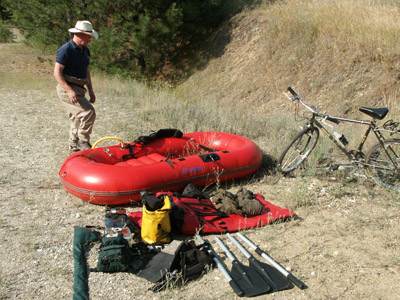
The next step is preparedness. Call the local fishing shops or rv parks close to the river and ask for updated river information, or ask for the name of a local guide or ranger. Each year after spring run-off, professional river runners navigate stretches of the river noting new channels, strainers and sweepers. This information gets passed around locally and shared with everyone who asks for it. Beginning floaters need to understand the power and dynamics of moving water. The most common obstacles or dangers are in-stream obstacles such as rocks and boulders, strainers, pillows, hydraulics, chutes and cliffs, which deflect the full force of the current. Shoreline obstacles also include rocks, strainers and sweepers, commonly found on all Montana Rivers.
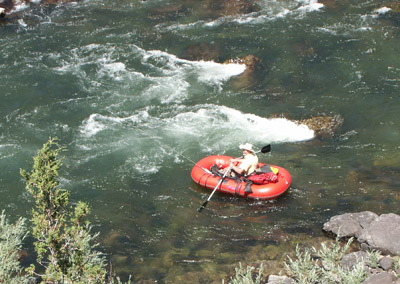
Broaching and obstacle sideways in a boat creates "a clear and present danger." With the possible exception of allowing the current to spin the boat backwards with the rower facing upstream, broaching a boat or raft is clearly the most dangerous position a rower faces. Sweeping broadside into an obstacle requires instantaneous reaction. Any delay and a rower is at risk of the obstacle sucking the boat down under the water, sometimes creating a wrap-around effect.
Broaching Escape Maneuver: In the following photograph, Dave Inks, inventor of the Water Strider one-man raft, demonstrates how to escapes broaching a rock on the Blackfoot River. He quickly pulls on his right oar, which spins him around to the side of the rock. He has already pulled in his left oar, and with his left hand he can push off the rock. What he doesn't do is lean too far into the rock, nor does he panic and shift his weight upstream, which could easily flip the boat, as he completes the maneuver. (
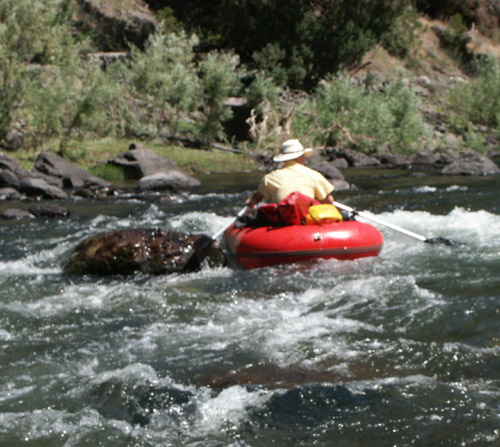
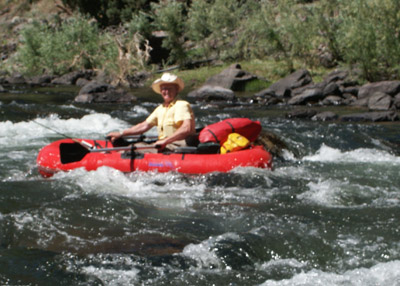
(Note: When I realized that Dave did not have a life jacket on him, I asked him to wear a life jacket and he declined. I was wearing mine!)
When I was a young fly fishing guide in Jackson Hole, Wyoming, I was guiding an elderly couple on the Snake River early in the summer. The water was very cold and still flooding its banks. I decided to take a small side channel. The tall meadow grass spilled sparkling rivulets of water into the side channel, and the pebbled bottom cast glittering rays of stream light. Wildflowers were abundant, and the cottonwoods showcased their new, yellow-tinted foliage. The Tetons loomed over us still snow-capped with their majestic, cragged peaks. We all sat in silence just taking in the scenery.
Rounding a corner we picked up speed as the gradient dropped. Suddenly in front of us was a strainer, a bare, single cottonwood trunk angling up out of the water and facing upstream. Strainers are extremely dangerous because the current is pulled downwards as it courses over a partly submerged tree. Wrapped around the strainer underwater was a green, seventeen foot Coleman canoe. We quickly glanced up to the bank overlooking this scene of disaster and observed three sullen men. I pulled into the eddy under the verdant bank they were resting on and asked, "Is everyone alright?" They were drenched. One man avoided our gazes entirely by resting his head between his knees. Apparently, we had just missed the accident. One of the men soberly replied, "We're alright now, but it was a close call."
The lady client turned to me with a quizzical look. I too was perplexed. At the deepest spot in this side channel, and on both sides of the strainer, the depth of water was no deeper than two and a half feet. Below the strainer the water welled up across a shallow riffle. The entire pool was less than ten yards long, and yet these men had ashen complexions and were clearly in shock.
It was impossible to extricate the canoe with four strong men. I thought it was a useless folly, but I joined in to help the men, as I sensed they needed to do something besides silently staring at the water. The force of water kept the collapsed canoe in place. I offered them a ride to the highway bridge. The nearly drowned victim said nary a word. The other friend was also reticent about sharing information on their mishap. The third man spilled his guts. He couldn't stop talking.
Captains and titans of the business world, these three imagoes were on a mission to buy a ranch or spread in Jackson Hole. Since it was a warm day, on impulse they decided to float the river. They stopped in at a sporting goods store, picked up a canoe and some paddles, bought a cheap ice chest and stocked up on beer. Life jackets were considered a frivolous expenditure for this spontaneous expedition. They drank heavily all day. By their own admissions, they had a number of close calls and near misses with the canoe. Each incident they roared with laughter and reached for another beer. Wanting to slow down a bit and enjoy the scenery, they took the side-channel and let their guard down. After all, it was shallow water.
On one of the turns through the meadow, the canoe turned sideways. The men laid down their oars and drank their beer, laughing out loud at all the anecdotal stories they would be able to tell their friends and family. Coming around the final corner, the water compressed into a fast riffle. Their view was obscured by the tall grass on the banks. They made no effort to straighten their course. Dropping down the riffle into the pool, they saw the strainer. The men clumsily grabbed their oars knowing they were going to capsize, get drenched and pull their laughing bodies up on the shore. It worked just as they had planned.
Into the water the man at the bow of the boat and the stern of the boat fell. Gasping for breath from the cold water they slipped and fell and dragged themselves up to the shore laughing like boys who had just pushed each other into a swimming pool at a birthday party. It was more than a minute before the duo realized they weren't a trio. They bolted upright and were stunned to see a scene completely absent of their friend, who had been seated in the middle of the canoe. The canoe was now under water and completely wrapped down both sides of the strainer. The top of the cottonwood was bouncing in agitation, as if it was in pain from the foreign obstacle enveloping it. The men shook off their stupor and charged for the capsized canoe.
They could feel the body of their friend under the canoe. He was wedged at the waist at the bottom of the tree trunk in less than three feet of water. His upper torso and his legs divided the strainer's sweep from the bottom to the surface. The two men could neither budge the canoe nor extricate their friend. Finally, one man pulled his friends legs downstream, while the other friend dove under the water and pushed the head and trunk up and around the trap. At least three or four minutes elapsed. The victim, thankfully, had just taken a deep breath as he glanced below the tip of the outreached tree trunk. He fought with all of his might to turn and twist free while under the water. At the moment his lungs gave out, he felt his friends tugging and pulling on him. He regained consciousness when they pulled him ashore.
Many years later I pulled a baby from a cottonwood tree in the middle of a slow section of the Bitterroot River, in Montana, just behind Hamilton High School. In their panic, the mothers kept diving into the water only to be swept below the tree and the stranded baby. When I came into view around a turn in the river, the women were screaming and waving their arms hysterically. I began pushing on the oars. I couldn't understand a word they were yelling, and then I spotted a year old baby.
The mothers had been inner tubing on a hot summer day with their children. None of them had life jackets on them or tied to their tubes. The hysterical mother with the lost baby had prudently prepared her baby for the float trip behind town. She placed Angel Wings on her baby's arms. In truth, the Angel wings saved the baby's life. When the current sucked the baby down between the branches, the arm floatation devices jammed in the branches. When I pulled up close to the drowned tree, I observed that the baby was face up. Her mouth was barely above water. She was coughing and spitting up water. The rescue was neither gallant nor noteworthy. I did not calmly return the baby to the mother. My own shock set in, and I found myself angrily lecturing this poor, sobbing mother as I delivered the baby to her arms. Later I felt miserable about my reaction. It was clearly not appropriate for the situation.
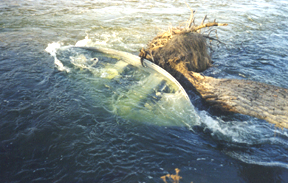
One nemesis for float fishers is sweepers. As the name implies, half-fallen trees overhanging the water lie in wait for anglers who concentrate more on their fly than the river ahead. After I gave up guiding in western Montana, my wife and I opened up a bed and breakfast establishment for fly fishers. I offered guided float trips on gentle sections of the river. Since I was not operating as a guide or operator of a boat or raft, I felt I was free of any liability in case of an accident. I gave a presentation the night before on oaring and safety. I repeated all the points prior to launching the next day. I insisted everyone wear life jackets, and I reminded them that we were all captains of their own little boat, and they were fishing and floating independently. In one summer I had a teenage boy and an elderly man knocked out of their small boats by sweeping branches. My son Darin was taking a business law class at the University of Montana. When the professor heard about these two incidents, he impressed upon Darin that I was risking a major law suit that I would lose. I ended the trips. I too have been surprised by sweepers on occasion. The advice seems too simple. Keep looking up and targeting obstacles for at least a hundred yards!
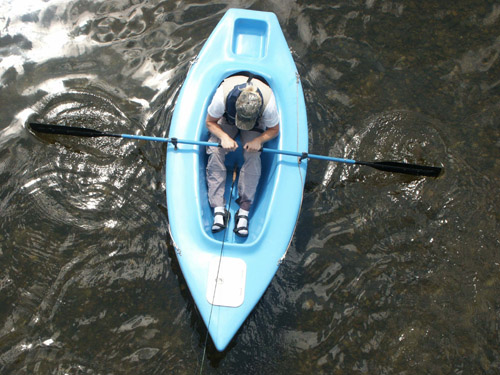
. A Hydraulic is a powerful, deep hole, which is usually found below a diversion dams (weir) or at a confluence with another river, when the water drops over a ledge. They should always be avoided. Sometimes they look very safe. Avoid them by portaging.
As a beginning rower, the beginner should immediately look for his or her first obstacle. An obstacle can be a mid-stream boulder, a strainer, a sweeper, a narrow chute, partially submerged rocks, current breaks, hydraulics and any other potential danger. It can even be the bank or shoreline that the current is moving towards. Once the first obstacle is established, the rower should position the boat so that the bow is facing the obstacle with the stern of the boat partially facing up stream. The rower is now in a position to row away from the first obstacle. As the rower faces the first obstacle, he or she should glance downstream for the second and third obstacle. Note in the following photograph that the first rower has allowed her boat to turn sideways, a dangerous position. Although Dave Inks' rafts are quick to respond, one should stay in the correct position to immediately row away from an obstacle. Note the angle of Dave's boat.
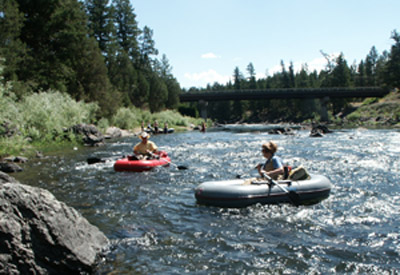
Look at every obstacle closely. Don't over react and expend a lot of rowing effort when a few pulls of the oar will be sufficient to slip by the obstacle. However, if the current is swift, and you are on a collision path, start ferrying your water craft laterally across the river away from the obstacle. Many beginners make the mistake of allowing the stern, or the back of the boat, to slip downstream ahead of them, which leaves them facing upstream in a dangerous situation. To avoid this keep the bow downstream with the stern at a 30 to 40 degree angle. In this position the rower will make progress across the stream away from the obstacle. Keeping the stern of the boat at an angle allows the boat to make progress laterally without danger of the stern of the boat spinning around. Rowers should never get in the habit of trying to push a boat to safety. To row away from an object, begin by thrusting your arms and the oars directly facing the object.
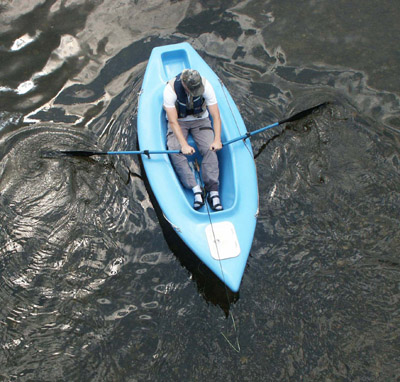
Dip the oars into the water (not too deep), and pull the oars to your chest. Most of us have more muscle, pulling power than pushing power.
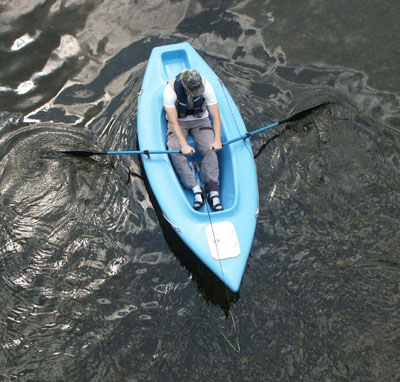
Prior to floating a Class II or Class III river, practice spinning your craft 90 degrees, 180 degrees and 360 degrees from both directions. My son Brandon Archer demonstrates this technique in one of my Little Dippers on the Bitterroot River. In the photograph below, Brandon pulls on his left oar while simultaneously pushing on his right oar. Practice these maneuvers until they become second nature or reflexive.
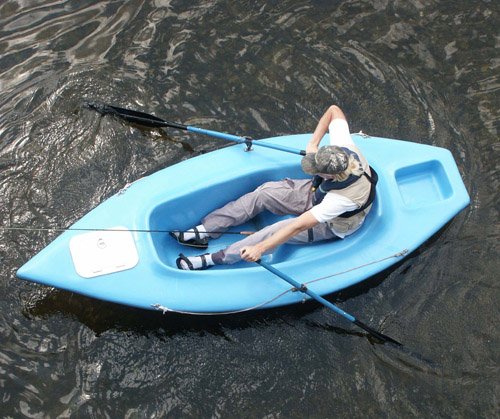
High Siding is an accident waiting to happen on the water. When passengers shift to one side of the boat, the weight shift tips the boat and robs the rower of his control. It is not uncommon to have someone spill out of a raft or drift boat when embarking for shore in shallow water. Someone falling and hitting their head on a rock can easily be avoided. The rower should take charge when he anchors the boat near the shoreline to exit passengers. The rower should exit first. If the water is not too deep on the outside, the rower should stand a thwart towards the middle of the boat and steady the boat as one angler at a time exits without rods in their hands. The easiest maneuver is one leg at a time with a shift in weight balance. Hold on to the gunwale or raft frame firmly. The rower can lift or tilt the boat slightly to help the departing passenger.
High Siding while the boat or raft is in motion rarely happens. People just know the obvious. High Siding on a strainer or a pillow seems to be a natural reaction that places everyone in the boat in danger. My first boating accident was when I had been guiding for three years in Montana. It was spring and the waters were high, fast and cold. Although the white water enthusiasts were enjoying themselves, it was folly to fish. My outfitter had out of town guests who wanted to fish large nymphs. I insisted they wear life jackets and belts on their waders. One of the clients did not have a belt, so I gave him mine. When I went to put on my own life jacket, I was surprised to discover that I had inadvertently grabbed a child's vest. This was probably twenty-five years ago, and I was wearing Seal Dry waders, a thin latex plastic wader that stretched and ballooned out like a sea anchor.
I was being as cautious as I could be. The clients were asking to move in closer to the shoreline and the spring sweepers. One of the gentlemen was fishing with a rod he had built. He was clearly proud of his creation. He was fishing with a lead-core shooting head with weighted Woolly Buggers. I repeatedly reminded him that he was catching the bottom, and with the speed of the current, if he hung up, the rod would be jerked right out of his hands. Right after the second caution, he hung up. His rod bent in an unbelievable arc, and he shifted the rod to the upstream side of the raft. He uttered something between a sigh and a short whimper and reluctantly surrendered the fly rod to the swift current.
I shot a glance downstream and noted the strainer towards the shoreline. I was convinced I had enough distance to save his rod. I spun the raft around using the push-pull oaring technique, flung the oars to the center of the raft, dropped to my knees on the bottom of the raft, leaned overboard and grabbed the tip of his fly rod. I jumped quickly to my rowing seat and gauged the distance to the outstretched tree trunk looming up in the middle of the river. I was lined up to broach the strainer dead even on the side of the boat. No problem I thought to myself, but when I leaned on the oars, I was shocked to discover how fast I was floating and how little progress I was making.
I faced a dilemma that all beginners should understand without equivocation. Never try to push the boat with the oars. Always pull away from the obstacle. I correctly reacted to the situation once I realized I was going to broach the strainer. I spun the boat around so that the bow was now facing the obstacle straight on. I yelled to the two men up front to reach out and push us away from the tree trunk, while I tried another hard pull on the right oar. It was a successful maneuver. We were just going to take a glancing blow. I didn't even need their help.
Just as I touched the strainer on its side, the two men stood up in the bow of the raft. I went mute as I watched in astonishment. Standing on the soft floor of the raft, both men leaned over the side and pushed. We were instantly high sided, and the bulging water along side the strainer pulled the boat under and flipped the 14-foot raft, all its equipment and three men like paper dolls. The two men floated over to the shoreline easily. When I came up to the surface, my waders had ballooned out with water, and I immediately began to sink, but not before I grabbed a roped which was tied to the side of the raft. Dropping down into a set of waves, I got spun around under the tipped raft. Then I lost my rope grip on the left side of the raft when I large wave pulled me completely out of the water.
I dropped under the water like a cannon ball falling off the poop deck. My eyes were open, and I could see trailing branches from a willow tree. I managed to grab a thin branch no thicker than my thumb. It was the last bush I could have grasped. A few yards downstream a log jam pulsed and shook from the current.. After I dropped off my two clients and filed a report, I went home to an empty house. I had just gone through a divorce. I was in shock for hours and couldn't sleep. The news of my accident spread through the guide ranks up and down the valley. I was ashamed of my incompetence and poor judgment, and I dreaded meeting the other guides. Strangely, no one ever made reference to my accident over the next fifteen years or asked me about it. I should have talked about it. It still haunts me to this day. I jeopardized the lives of my two passengers for a fly rod.
When you need a rowing break, and you find yourself in dangerous, boulder strewn waters, look for an Eddy - a pocket of quiet water behind a large boulder or a narrow slice of shoreline from a slope or boulder field. The water tends to circle around and move upstream. Here you can rest quietly by just feathering the oars before you push off again.
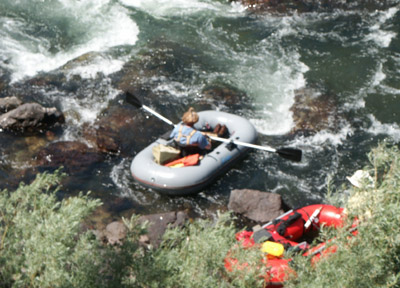
Always scout the river ahead. If need be you can easily tie a line to your boat and safely walk the boat through a dangerous section. If you are in a group, the most experienced rower should be the lead rower. He or she can wave the group on if the route is safe. Let the leader navigate through the rough section first, and one-by-one the rowers behind may follow his or her path to safety.
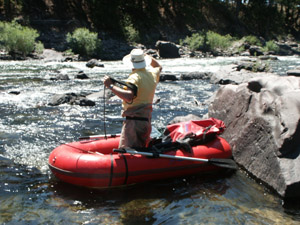
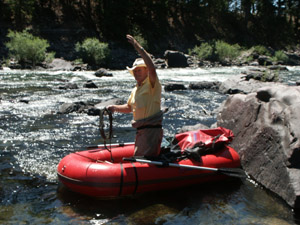
Sometimes a Pillow, which is an up surging pillow of water when a strong current is pushed up against a bridge abutment or large rock, can actually deflect you away from the wall, abutment or cliff. However, they are, nonetheless, dangerous and the rower should take action to avoid them.
These are just some of the challenges of floating a river. Beginning float fishers should begin on slow, moving water in order to practice good rowing techniques and casting techniques. Only experienced rowers should attempt to navigate mountain streams strewn with boulders.
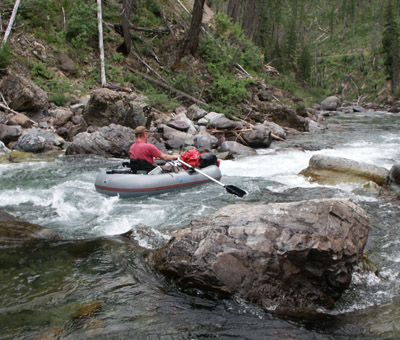
Instead, practice boat handling skills and fishing skills on slow moving waters that hold big fish. What follows is a quick summary review.
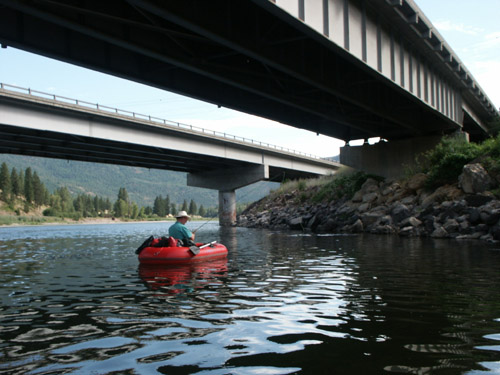
Summary Review: One of the best books that I have read on river floating is Stan Bradshaw's book, River Safety. ISBN: 1-890373-08-7
1. Wear a Life Jacket at all times.
2. Stock your Dry Bag with safety provisions. Include the following: a first aide kit; a pocket knife; extra clothes and rain gear; a stocking cap; rope; flash light; food; a plastic tarp; water bottle and water filter; patch kit.
3. Obstacles: Look for your first obstacle, such as the current pushing into the approaching bank. Other obstacles are rocks, side-currents, sweepers, strainers, hydraulics, log jams, bridge abutments etc.
4. Practice ferrying across current, and practice the push-pull oaring technique for quick boat maneuvering.
5. If you are thrown or tipped out of your raft, roll on your back with your feet facing downstream. In this position you may push off rocks and other obstacles. Once you are in the clear, swim for shore. (Bradshaw's book is filled with self-rescue techniques, as well as assisted rescue. It should be required reading!)
6. Check out river conditions prior to launching, and be prepared for adverse weather changes.
7. Always scout challenging or dangerous water. If necessary, line-out your boat or portage around the section.
8. Always keep your boat pointed at the next obstacle. Be prepared to PULL the oars. Your boat should be at a 30 to 45 degree angle.
9. Keep looking ahead as far as a 100 yards. Do not allow your fishing to interfere with safe boating practices.
10. Never drink or take drugs prior to floating a river, and certainly not while you are on the water.


